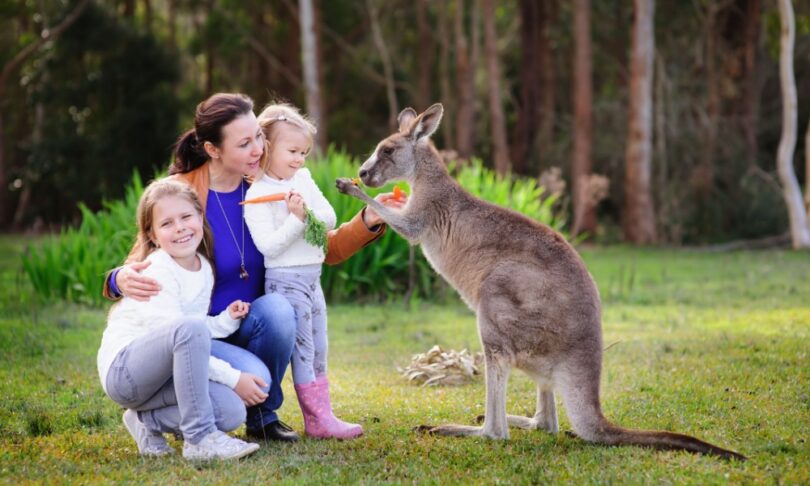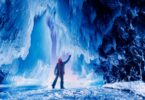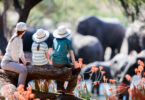From cuddly kangaroos and koalas to fierce Tasmanian devils and clever platypuses, Australia is no stranger to amazing animal life. Owing to its isolation from the rest of the Earth, its own rich ecology, and diverse environment, Australia is home to some of the most beautiful and often downright odd animal life in the world.
No matter where you go in Australia, you’ll find exquisite wildlife both here and the wider Oceania region. Whether you’re on a trek through the iconic outback, sitting down for a cup of tea at an outdoor café in Canberra, or kayaking down a river at one of country’s beautiful national parks, you’ll be head over heels for the Land Down Under’s remarkable animal residents.
Here are our top picks for the most amazing examples of Australian animal life to be on the look for next time you find yourself in Australia.
Kangaroo

Eastern grey kangaroo with joey
One of Australia’s most recognizable animals, kangaroos are found all throughout the continent, with particularly large populations in the rugged savannas of the outback. Known for their powerful hind legs and their signature hop, kangaroos are Australia’s largest marsupials, animals that nurture their young in a small pouch in their abdomen. Sometimes growing over 6 feet in height, these animals can cover 25 feet in a single hop and reach speeds of 35 miles per hour at a full run. The star attraction of Australia’s largest wildlife sanctuary, Kakadu National Park, kangaroos can also be spotted living in their native environment on the appropriately named Kangaroo Island.
Koala

Koala
Famous for their cute faces and cuddly appearance, koalas are one of Australia’s most recognizable animals and a favorite subject for visitors looking for Insta-worthy snaps of Australian wildlife. Contrary to popular belief, koalas are not bears, but rather marsupials like their larger friends, the kangaroos. Relishing a calm, solitary existence, koalas spend most of their time munching on eucalyptus leaves in the many trees that dot the landscape of their home in Victoria, New South Wales, and Queensland. Sometimes sleeping for up to 18 hours a day, koalas have very strong limbs that are expertly adapted for hanging onto tree branches for long periods of time.
Platypus

Platypus
Few of the world’s animals have as distinct physical characteristics as Australia’s resident odd bird, the platypus. Actually, despite its ducklike appearance, the platypus is not a bird, but a mammal. Appearing almost like a creative mish mash of multiple different animals, platypuses possess a bill and webbed feet, the flat tail of a beaver, and a coat of beautiful, waterproof fur. Even stranger, semi-aquatic platypuses are one of the few mammals in the world to lay eggs, making their nests along Australia’s riverbanks. Platypuses are best spotted adjacent to the shoreline of lakes, rivers, and streams of Victoria, New South Wales, and Tasmania, where they feed off a variety of shrimp, insects, and small fish.
Emu

Male Emu and chicks drinking at waterhole
Standing just behind ostriches as the second tallest bird in the world, emus are among the most fascinating avian residents in the world. Honored with a place on Australia’s Coat of Arms, emus can reach heights of 6 feet tall and run at speeds of 35 miles per hour. While found throughout Australia, emus generally prefer the open grasslands and savannas of the outback. Powerfully built with long necks, muscular legs, and soft, brown plumage, these flightless birds are omnivores, eating everything from plants and fruits to insects and small rodents.
Tasmanian Devil

Never test the patience of a Tasmanian devil…
Boasting a reputation for fierce aggression and ravenous hunger, the Tasmanian devil is the most well-known four-legged resident of the island of Tasmania, a small state to the south of mainland Australia. Averaging only 26 inches in length, Tasmanian devils nonetheless pack a powerful punch, possessing the strongest bite relative to size of any animal in the world. Despite their fearsome physical attributes, devils are timid when confronted by humans. They feast on birds, snakes, and small mammals. Primarily nocturnal animals, devils inhabit the forests of many of Tasmania’s national parks, including beautiful Freycinet.
Quokka

Quokka
Adorable marsupials famous for being the “happiest animal in the world,” quokkas are perhaps Australia’s cutest and most sociable animals. Famously found in the wetlands and shrubs of Western Australia, quokkas are best known as residents of sandy Rottnest Island. Quokkas are short in stature, running about the size of a house cat, and feature a round, furry frame and short tail. Naturally inquisitive, quokkas often approach hikers and other humans who happen upon them in the wild. Boasting a perpetual smile thanks to their facial structure, quokkas are the subject of many selfies and have become a viral sensation among nature-loving social media users.
Wombat

Wombat
A close relative of the koala and kangaroo, the wombat is one of Australia’s most celebrated marsupials. Wombats can be found in a variety of different habitats throughout the continent, from coastal wetlands to grasslands to high mountains. Wombats come in three different species, but all of them possess the same sturdy, rectangular body shape that helps them burrow into the ground and fight off predators. Usually solitary, they only leave their burrows for a few hours each night and subsist on a diet of grass and shrubs.
Kookaburra

“Laughing” kookaburra
Kookaburras are among Australia’s most beautiful bird species, but they are best known for their highly unusual calls. The kookaburra possesses a song that is very similar to raucous human laughter, which it uses to outline its territorial boundaries. You may have sung about them when you were a kid: “Kookaburra sits on the old gum tree / Merry merry king of the bush is he / Laugh, kookaburra, laugh kookaburra / Gay your life must be.”
Although they reside in most of Australia’s forested areas, kookaburras also frequently visit cities and suburban neighborhoods, making them easy to spot for tourists. Adorned in white and brown plumage, kookaburras feast on a diet of snakes, insects, and rodents. These skilled hunters and attentive parents patiently wait for their prey and bring them to nearby perches to feed their young.
Dingo

Wild dingo dog in South Australia
Australia’s noble species of wild dog, dingoes are the continent’s largest carnivores and have a storied place in the country’s history. Dingoes first appeared in Australia over 4,000 years ago, and reside nowadays in a plenty of different habitats throughout the nation, though they generally prefer the grasslands of central Australia. Although markings can differ, dingoes most commonly have a brown or tawny coat with white paws. These solitary hunters usually stick to small game like rabbits and wombats but have been known to hunt larger animals like kangaroos if they join a pack.
You Might Also Enjoy: Headed Down Under? Check Out These Great Destinations in Western Australia
Wallaby

Red-neck Wallaby with joey in pouch
You could think of the wallaby as the younger sibling of the iconic kangaroo, possessing many of the same physical characteristics of its more famous kin, albeit in miniature form. Averaging a petite 3 feet in height, wallabies can be found throughout Australia, with populations taking up residence in places as diverse as the rocky passes of northern Australia and the arid plains of New South Wales. The habitat of a particular wallaby has a heavy influence on its markings, which can range from brown to light gray. These cute herbivores, accustomed to grazing on grasslands, usually join together as a group while they’re feeding but are otherwise solitary animals.
FAQs:
Q: What is the best time of year to visit Australia for wildlife spotting?
A: The best time for wildlife spotting in Australia is during the spring (March to May) and fall (September to November), when temperatures are moderate and many animals are more active. However, certain species may be easier to spot during the cooler winter months.
Q: Are there any wildlife safety precautions I should be aware of?
A: Yes, always maintain a safe distance from wildlife, for your won safety as well as for theirs. Avoid feeding animals, and always follow local park guidelines. Some animals, like kangaroos and dingoes, can be unpredictable, and others require caution in their natural habitats.
Q: Can I interact with any of the animals mentioned in the article?
A: Some wildlife parks and sanctuaries in Australia offer opportunities to interact with animals like kangaroos, koalas, and wombats in controlled environments. However, wild animals should be observed without direct interaction to ensure their safety and yours.
Q: Where can I find wildlife tours in Australia?
A: Many national parks and wildlife sanctuaries, such as Kakadu National Park and Kangaroo Island, offer guided tours for animal lovers. Check with local tourism boards or visitor centers for recommendations on eco-friendly tours.
Q: What should I pack for wildlife viewing in Australia?
A: Pack comfortable outdoor clothing, sturdy shoes, sunscreen, a hat, and insect repellent. Binoculars and a camera are essential for spotting and capturing wildlife. Depending on the region, you may also need a jacket for cooler evenings.
Q: Are there any endangered species I can see in Australia?
A: Yes, Australia is home to several endangered species, such as the Tasmanian devil and some species of wallabies. Conservation-focused wildlife parks offer the chance to see and learn more about these animals and the efforts to protect them.
Have you ever met any of these animals face to face during a trip to Australia? Let us know in our comments section below!








